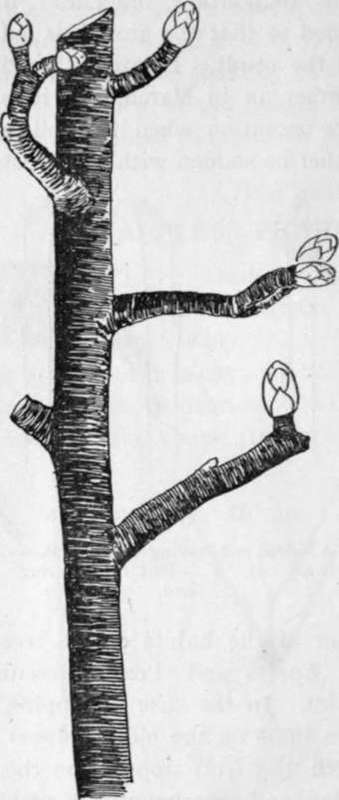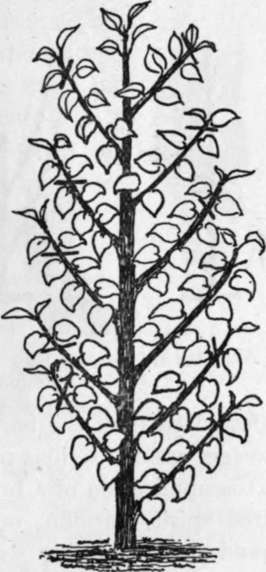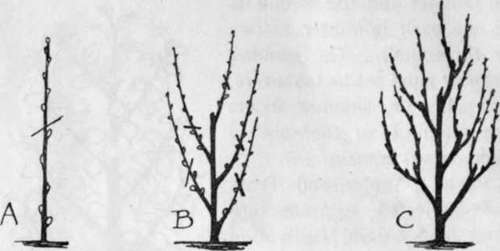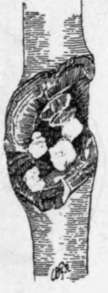Pears
Description
This section is from the book "School Gardening", by W. Francis Rankine. Also available from Amazon: School Gardening.
Pears
This fruit offers less difficulty, since the yield is borne on the old wood, and pruning is carried out in order to remove the young shoots. As in Apples, this operation may be executed in two stages. The first step is to reduce the young shoots in summer and the second is to cut back in winter to two or three buds. The summer pruning must not be too severe, and only the summer shoots are removed so that six to eight leaves remain.

Fig. 63. fruit spurs.
Pests
Apples and Pears are subjected to numerous pests, and careful cultivation is very necessary in order to safeguard the trees from the ravages of certain insects and fungi. Among the former are American Blight or Woolly Aphis, the Codlin Moth, Winter Moth, and Apple Blossom Weevil, while the chief among the latter is canker.
American Blight or Woolly Aphis (Schizoneura lanigera). One cannot mistake the presence of American Blight, because of the patches of white, downy flakes that develop on infested trees. These white, woolly appearances are the aphides themselves, or at least the quaint covering which they bear. Directly these signs of invasion are detected, steps must be taken to ensure the removal of this insidious pest. If it be neglected, serious harm to the trees is assured, for not only does the Woolly Aphis cause direct destruction, but it predisposes the infested parts of the bark to attacks of canker when its ravages assume serious proportions. The best treatment is the application of a brush, dipped in sweet oil, methylated spirit, paraffin, or petroleum, to the colonies of aphides, or spraying with a solution of paraffin, soft soap, and quassia. This operation must be carefully done and repeated directly fresh developments of the pest occur.

Fig. 64. Forming A Cordon Tree.
The laterals are cut back in summer to six leaves as shown and in winter to two good buds.
The Codlin Moth (Carpocapsa pomonella). The Codlin Moth is a serious pest to apple growers, and its ravages, if unchecked, may render the orchard worthless. The moth places its eggs in the eye of the fruit in late spring, just before the eye closes. The egg hatches, and a small caterpillar, familiar to most people, commences its journey in the course of which the pips are eaten, the fruit falls, and the enemy promptly leaves it to take up its pupal quarters in the ground. In consequence of this destructive work the Apple is rendered more or less unfit for consumption. All Apples which fall should be consumed at once or destroyed so that the larvae occupant does not complete its cycle of changes to appear as a new enemy.

Fig. 65. Forming A Pyramid.
A.-Maiden tree headed back. B.-Laterals cut back to three buds. C.-Pyramid or upright bush tree.
The best remedies are sprayings of Paris Green, and liming the bark of the tree. The spraying must be carried out before the eye of the fruit turns down, so that the egg or the larvae is destroyed. After this time spraying is useless and the larvae develops unhindered.
Winter Moth (Cheimatabia brumata). The females of this species are wingless and crawl up the tree to place their eggs in crevices in the bark and on spurs. When the larvae appear they feed on the buds. The male moth is commonly seen on the wing during the evenings in the last week or so of the year. Before October the trees may be grease-banded in order to intercept the females on their journey up the tree. The stems or shoots should be sprayed in order to destroy the eggs and larvae of the pest. Moss or lichen aid in harbouring the eggs of the moth. Spring sprayings with Paris Green are effectual checks; while winter washings with a solution of caustic soda and commercial potash are excellent.
Canker
This is a fungoid pest, persistent in character, and difficult to exterminate. The spores attack unhealthy portions of the bark, and on account of this, great care must be exercised in order to avoid wounds on the outer covering of the tree. The rubbing of one branch on another when pruning is neglected, or the wounds caused by frost are a few of the indirect causes of the appearance of canker. The infested areas, when small, may be carefully cut away and the wound smeared with Stockholm tar. When the disease is acute the tree should be either removed or headed back and grafted with a strong strain such as Bramley's Seedling in the case of Apples, and Pitmaston Duchess in Pears.

Fig. 66 american blight on canker wound..
American Blight or Woolly Aphis (Schtzoneura lanigera) on cankered branch of an apple. The white patches are the aphis colonies.
Continue to:
